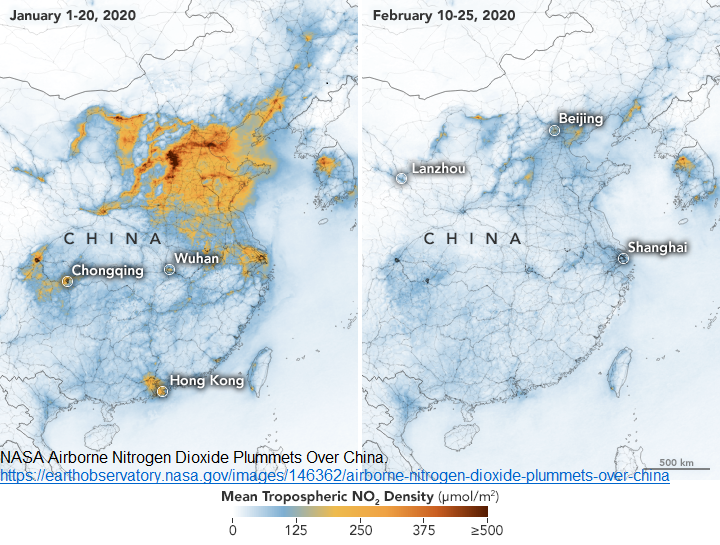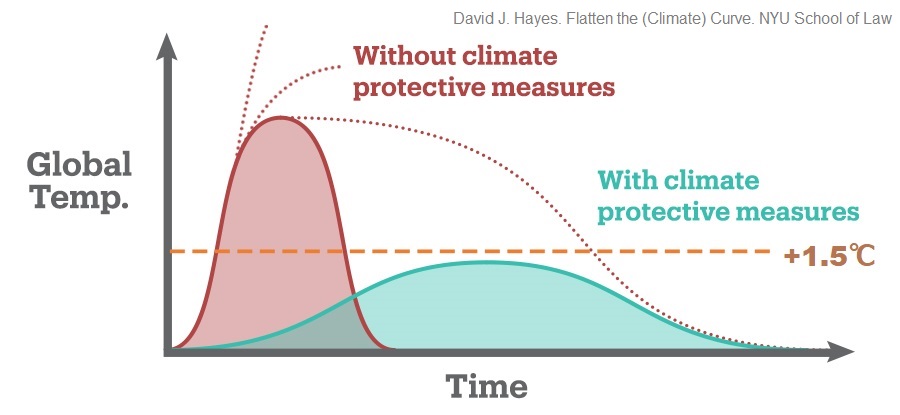Pick Up
20. New Coronavirus Pandemic ― Global Economic Crisis and Climate Change Countermeasures

On April 20, 2020, the price of a barrel of West Texas Intermediate (WTI), the benchmark for US oil, temporarily fell as low as minus $40 a barrel at the New York Commercial Exchange, the lowest level since its listing in 1983. As the global economy becoming stagnant due to measures to suppress the COVID-19 pandemic, there is an excessive supply of crude oil and the storage capacity has reached its limit due to a sharp decline in demand. This reflects a situation in which the sellers are paying the buyers to take the commodity off hands.
Since the end of January 2020, the COVID-19 outbreak that has been storming the world has caused a temporary decrease in greenhouse gas emissions through the suspension of economic activities. NASA's satellites which monitor air pollution have detected significant decrease in the concentration of nitrogen dioxide (NO2) after the lockdown started around Wuhan, China on January 23, 2020 (Fig. 1). NO2 is a short-lived pollutant with a lifetime in the atmosphere of about one day, thus this pollutant stays near the emission sources and can be used as a proxy of the intensity of economic activity in different sectors (Japan Times). Improvements in environmental pollution have been reported from around the world. In Venice, water in the canals has become cleaner due to the reduced number of tourists. In India, which chronically suffers from the worst air pollution in the world, it is reported that the Himalayas can be seen from town for the first time in decades.
Looking back on the past year, 2019 was a year in which there was an increase in global awareness and attention to the urgency of mitigating and adapting to climate change. The United Nations Environment Programme (UNEP) warned that unless global greenhouse gas emissions fall by 7.6 per cent each year between 2020 and 2030, the world will miss the opportunity to get on track towards the 1.5°C temperature goal of the Paris Agreement. The fallout of economic activity due to the COVID-19 pandemic is ironically "kind to the planet." Experts assumed 5% or more drop in carbon dioxide emissions, something not seen since the end of World War Two and even the fall of the Soviet Union are likely to have affected emissions the way this crisis is (World Economic Forum, April 4, 2020). However, climatologists say that the emission-reducing effect of the COVID-19 pandemic will not last long, and if fossil fuel use would have to decline by about 10 percent around the world and would need to be sustained for a year to show up clearly in carbon dioxide levels (Scripps Institution of Oceanography). After world greenhouse gas emissions dipped by 1.4% in the aftermath of the 2007-2008 global financial crisis, they shot back up a whopping 5.1% in the recovery In this coronavirus crisis, greenhouse gas emissions fell by about 25% in China due to plant shutdowns and lockdowns, but it seems that emissions are returning to a normal range as economic activities resume (World Economic Forum April 4, 2020).
In order to avoid future irreversible climate change risks, a drastic socio-economic transformation of the land and energy sector is essential regardless of the coronavirus crisis (The Science Advisory Group of the UN Climate Action Summit). Climate experts say that responding to the coronavirus crisis can provide lessons for avoiding it. As of April 2020, the word “corona epidemic curve” has been heard in the news as the emergency declaration was issued in Japan and the social distance strategy was adopted. According to public health experts, infections will settle faster if the epidemic peaks are high, but to avoid possible collapse of medical services in the process, it is recommended to lower the infection peak and flatten the epidemic curve. Scholars propose to regard extreme weather events caused by climate change as a viral infection and aim to improve the resilience of society by swiftly promoting the decarbonization of the economy to curb the rise in the average temperature of the world thus to avoid catastrophic damages to the society (Figure 2: Hayes, March 31, 2020; World Economic Forum April 17, 2020).
In response to the current global economic crisis that could be comparable to the Great Depression of 1929, it is expected that large-scale economic stimulus packages in developed countries will be implemented and support assistance to developing countries will be called for. COVID-19 has proved that that disasters do not respect borders, that solidarity brings strength, that science and expert advice matter, and that delay is deadly. The same lessons hold true for our climate emergency. Experts view this crisis as an opportunity to tackle climate change, replace the business-as-usual situation, and under international cooperation, to invest in resilient and sustainable infrastructure to build a new green economy (World Economic Forum April 17, 2020).
The COVID-19 crisis has revealed a trade-off between global economic activities and climate change mitigation. From a long-term perspective, however, immediate response will be a shorter way to sustainable future while delays in mitigating and adapting to climate change can result in massive social and economic loss s. Fortunately, the return on investment in improving resilience to climate change can bring a “triple dividend”, namely, avoiding future losses, generating economic gains through innovation, and delivering social and environmental benefits (Global Commission on Adaptation). As agriculture, forestry and other land use (AFOLU) sector accounts for 23% of the anthropogenic GHG emissions, food and nutrition security must be achieved through strengthening the resilience of food supply chains and investing in sustainable agricultural intensification through sustainable and stable use of agricultural resources.
References
David J. Hayes. Flatten the (Climate) Curve. NYU School of Law. March 31, 2020. Accessed on April 20, 2020.
Global Commission on Adaptation. 2019. ADAPT NOW: THE URGENCY OF ACTION.
Japan Times. Air quality improving in quarantined countries. March 22, 2020.
NASA. Airborne Nitrogen Dioxide Plummets Over China.
Scripps Institution of Oceanography. What does it take for the coronavirus (or other major economic events) to affect global carbon dioxide readings?, March 11, 2020.
The Science Advisory Group of the UN Climate Action Summit 2019. United In Science - High-level synthesis report of latest climate science information.
UNEP. (2019) Emissions Gap Report 2019 https://www.unenvironment.org/resources/emissions-gap-report-2019
World Economic Forum. Coronavirus could trigger biggest fall in carbon emissions since World War Two - but any decline could be short-lived. Accessed on April 20, 2020.
World Economic Forum. Flattening the climate curve in the post-COVID world. April 17, 2020. Accessed on April 18, 2020.
Contributor: IIYAMA Miyuki (Research Strategy Office)


